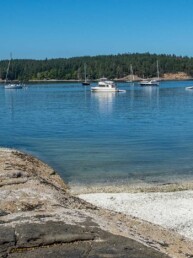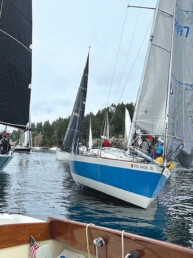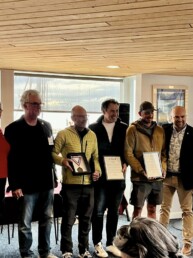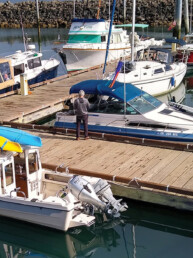This article was originally published in the January 2022 issue of 48° North.
It was a miserable February day in 2012, a gray slush dripping from the leaden sky as my wife, Deborah, and I walked carefully down the dock at a marina in Poulsbo to take our first look at the 1984 Passport 40 sailboat that would soon be ours.
She looked absolutely perfect.
Maybe it was the lighting — or the lack thereof. Maybe it was the damp cold that quickly drove us down below, where we didn’t linger too long because it was cold down there, too.It didn’t matter. We loved what we saw and we felt, in our bones, that this was the right boat for us.
But she wasn’t perfect. Far from it.
This winter, after nearly 10 years of ownership, countless projects large and small, and thousands of miles under her keel, she is closer than she hasever been to that first vision of perfection.
As I write this in early December 2021, I’m preparing to take our beloved boat, Rounder, up to Anacortes for a three-month haulout. Working with our friend Ethan Holson, who is a skilled craftsman in fiberglass and boat repairs, we will build a new rudder and overhaul the cockpit. If all goes well, it will be the last of the major “winters of work” that have taken place to refit this wonderful vessel.
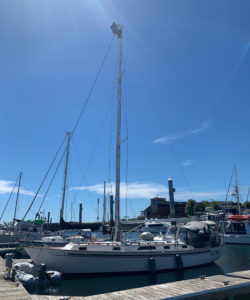 I’ve learned a lot of lessons during this refit journey — for me, they boil down to this:
I’ve learned a lot of lessons during this refit journey — for me, they boil down to this:
1. Have a goal for what you want the boat to be and to do. For us that meant a boat that would take us comfortably and safely on a long-distance cruise for up to a decade.
2. Find a balance between working on the boat and playing on it. We’ve always tried to wrap up major projects by the end of spring so we could enjoy our boat during the best months of the year in the Pacific Northwest while learning what we needed to do next in our refit.
3. Do as much of the work as you can yourself. You will learn so much about your boat and how to fix it when you get your own hands dirty and need to problem-solve and troubleshoot.
4. For projects that you can’t work on yourself, find trusted advisers and professionals. Experts who are willing to share their knowledge — whether in a book or website, or by letting you work side-by-side with them — will save
you more money and hassles in the long run than you will pay them for their services.
I’ve learned that I’m one of those folks who enjoys the challenge and problem-solving involved in maintaining and improving a boat. Maybe not as much as I love the sailing and cruising part, but enough that I’m more than willing, even after 10 years, to roll up my sleeves and dive right into yet another project in pursuit of that vision of perfection. Without this strange predilection, I’m not sure all we have accomplished would have been possible.
In greater detail, here are how these four lessons have worked for us:
Have a goal for the boat
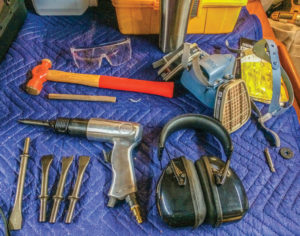
We didn’t really know what we were in for when we purchased the boat, which in hindsight was a good thing, since there is no way we would have signed up for the amount and cost of the work involved if we had. But we also don’t regret the decision, because we now have a boat that we know literally inside and out. We’ve laid hands on each and every major system and have poked, prodded and, in some cases, replaced structural pieces.
The first thing we did right with our boat is that we had a very clear plan for what we wanted her to do — take us safely and comfortably long-distance cruising. She would need to be capable of crossing oceans and taking us off-the-beaten-path cruising for up to a decade. All of our decisions about projects, equipment and approaches stemmed from that basic vision.
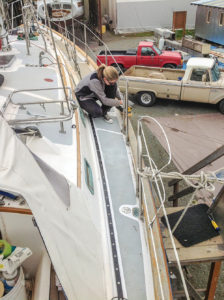
When we purchased the boat, we had a thorough survey done and a list of need-to-do projects right off the bat. But we also knew that we had a boat with very solid bones, even if many of the systems were nearing their end of life and the boat’s fit and finishes were badly faded.
Fortunately, the previous owner had just repowered the boat, so at least putting in a new Yanmar engine was not on the to-do list.
After clearing the list of projects from the survey, we spent that first summer intimately getting to know our new-to-us boat. That process was invaluable.
Use the boat
By using the boat, we had an opportunity to really learn what worked well for us and what we felt needed improvement. And in each subsequent year, we cruised long and short distances, seeking further opportunity to stretch ourselves as cruisers and to stretch the boat. We called this process “dialing in the boat.” Not only did it help us determine what we wanted to fix or improve, it also helped us prioritize the forthcoming projects.
Through this process, we learned a few things.
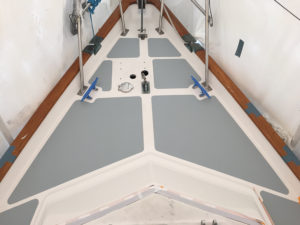 We learned just how awful the boat’s sanitation system was. The head was unreliable. The hoses were permeated and run through a maze of valves and jury-rigs. Also, the integral fiberglass holding tank smelled like there was a dead body stuffed inside. While we were fixing those issues, we figured we might as well also renovate the entire shower and head compartment with new paint and varnish.
We learned just how awful the boat’s sanitation system was. The head was unreliable. The hoses were permeated and run through a maze of valves and jury-rigs. Also, the integral fiberglass holding tank smelled like there was a dead body stuffed inside. While we were fixing those issues, we figured we might as well also renovate the entire shower and head compartment with new paint and varnish.
We learned that the icebox wasn’t well-insulated and the fridge was dying. Since we needed to reinsulate and rebuild the entire thing, we decided to create both a refrigerator and freezer. And since tearing out the old icebox meant removing the tired countertops, we replaced those and put in a new, larger single sink (instead of the double sink the boat came with) and faucet while we were at it.
We learned that fixing any electrical issue in the rat’s nest of wires that had developed over the decades was difficult — if not dangerous — and that the entire system needed to be overhauled. Since we were so deep into it, it made sense to also upgrade the distribution panel and reconfigure the nav station around it. And after removing some of the existing wire runs, we saw enough things that concerned us that we decided to go ahead and replace every wire aboard the boat.
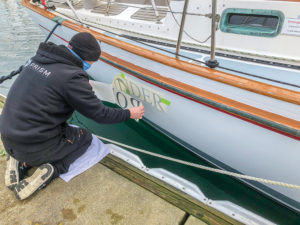
We learned that the freshwater system was original, the clear plastic hoses fouled with years of build-up. So it was out with those hoses and in with Pex tubing, modern connectors and a water manifold that provided flexibility for selecting which tank to use and options to use freshwater for flushing a watermaker and adding a cockpit shower. We added proper filtration to the whole system and inspection ports in the tank for easy access and cleaning.
We learned that the rig and sails would be OK for a few years, but they would definitely need replacing before any serious voyaging. By sailing the boat, we had a good sense for what we wanted in new sails and what type of sails worked best for us. We also knew what pieces of equipment worked and what didn’t. The chainplates were suspect (and turned out downright scary when I finally pulled them). The traveler didn’t travel under load. Many of the turning blocks and much of the running rigging was tired, and boy, did that mast and boom need some new paint.
We decided that the tired teak overlay on the side decks needed to go — for no other reason than to make sure that hundreds of screw holes into the deck core hadn’t caused any delamination. And the hull, with weeping spider cracks in the filler below the toerail and its splotchy, banged-up appearance that resisted any and all attempts to make it even slightly better, just had to be addressed. Today, the deck and hull look amazing.
All of these projects are just examples of what we tackled while working our way from stem to stern and top to bottom over the past 10 years.
Do it yourself
As much as possible, I tried to tackle the various projects myself. From the start of the rainy season in November through the end of April and sometimes beyond, I have spent my weekends and free days puzzling my way through boat projects. Deborah took to half-jokingly calling herself a boat widow during those months, and she wasn’t wrong. But at least she was forgiving.
During the week, I would pore over resources, post questions and research products as I learned new skills and approaches to make sure I was doing a project correctly and to high standards. I called these skills the “dark arts” of boating and would beam with pride as I got the hang of basics like wetting out fiberglass, splicing an eye in double-braid line, crimping wire terminals and many, many more.
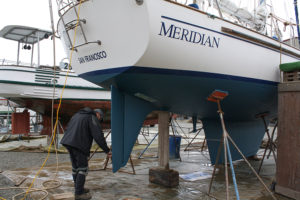
I joked that I was slow and stupid, but at least I was cheap! The reality was that I had high standards and wasn’t about to take shortcuts or settle for “good enough.” At the end of the day, we would be the ones who would have to live with the results.
By working on these projects, we quickly got to know the places and people in the local marine trades industry that we could rely on for good advice and quality support. Sometimes that support was provided face to face, with patient explanations and detailed answers to repeated questions. Other times, it was provided on the pages of websites and in books.
Experts who you can trust
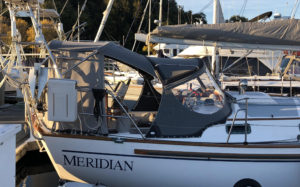 The common thread to those resources and people who I came to trust was that they had deep knowledge and they were willing to share it. I came to learn that many boaters never stopped to ask these experts to share their expertise. When I showed interest, they tended to open up and let me into their sometimes obscure worlds. It was wonderful.
The common thread to those resources and people who I came to trust was that they had deep knowledge and they were willing to share it. I came to learn that many boaters never stopped to ask these experts to share their expertise. When I showed interest, they tended to open up and let me into their sometimes obscure worlds. It was wonderful.
But even with patient support, many of the biggest projects required skill sets that would be difficult to develop without years of study and experience. From that, I learned it was important to recognize when I needed to turn to a professional to get the job done right.
And here, too, I gravitated to those craftspeople who were willing not just to do the job I was paying them for, but who would encourage me to dive into the project with them and work side-by-side when possible. Engine mechanics. Rigging. Sailmaking. Fiberglass. In each area, I found people who were mentors as much as they were service providers. They shared their knowledge gladly and I hope they enjoyed my engagement in the project as much as I enjoyed learning from them.
Paying for that help isn’t easy — like most folks, we too needed to scrimp and save and make other sacrifices to afford having a boat in our lives, especially one that we are slowly refitting. But the knowledge I gained from working with experts was invaluable and has positioned us to be more self-sufficient when we finally do get going on that long-distance cruise.
This winter, I will be engaging in another masterclass in fiberglass with my friend and mentor Ethan and his assistant, Michael. I will get to learn how to build a proper rudder and a lot more about finishing and repairing gelcoat, among other things. We will puzzle through how to improve the rudder bearings and steering system. I’m really excited.
When we relaunch the boat, she will be even closer to that vision of perfection, that mirage that tantalized us so many years ago. We’ve had to change so much about this boat, but as I look back now, I wouldn’t change a thing in how we went about it. Truly, those four lessons have guided us through it all.

